The crypto channel is the superconductor of payments, providing faster settlement times, lower fees, and the ability for seamless cross-border operations.
Written by: Dmitriy Berenzon
Translated by: Will Awang
As we step into 2025, blockchain has gradually built a financial payment ecosystem parallel to the traditional financial system. The crypto payment channel has already carried a volume of $200 billion in stablecoins, with a trading volume of $56.2 trillion in stablecoins in 2024, according to adjusted data from Visa, which is more applicable to payments themselves and is nearly equivalent to Mastercard's annual transaction volume. According to the statistical criteria of Cathie Wood ARK Invest's report, in 2024, the annualized trading volume of stablecoins is expected to reach $15.6 trillion, approximately 119% and 200% of Visa and Mastercard, respectively.
Regardless, the popularity and large-scale adoption of crypto payments is an undeniable fact, especially represented by Stripe's $1.1 billion acquisition of stablecoin service provider Bridge. As Stripe CEO Patrick Collison stated, crypto payment channels are the superconductors of payments. They form the foundation of a parallel financial system that offers faster settlement times, lower fees, and the ability for seamless cross-border operations. This idea took a decade to mature, but today we see hundreds of companies working to make it a reality. In the next decade, we will see crypto channels become the core of financial innovation, driving global economic growth.
Previously, we have introduced the Web3 crypto payment system built on blockchain infrastructure through several articles on Web3 payments:
Web3 Payment Comprehensive Report: Industry Giants' Full-Scale Attack, Expected to Change the Existing Crypto Market Landscape, which explains how Web3 payments are constructed and the market layout of major players in 2023;
Web3 Payment Comprehensive Report: From Electronic Cash, Tokenized Currency, to the Future of PayFi, systematically introducing how Web3 payments evolve from electronic cash to tokenized currency/digital dollars, and future development trends. Also refer to Circle 2025 USDC Market Economic Report: Digital Dollars on the Value Internet.
Web3 Payment Comprehensive Report: How Stablecoins Will Evolve in 2025, examining the situation from the perspective of stablecoins.
The following articles will combine the perspective of global crypto payment regional market adoption, as the different logics of financial efficiency transformation in the Northern Hemisphere and inflation-resistant value storage in the Southern Hemisphere create a situation where you are in "Dream of the Red Chamber" while I am in "Journey to the West." Furthermore, since both payments and currencies are on-chain, how crypto payments can combine with DeFi to achieve maximum payment utility is also a future trend, which we refer to as PayFi or DeFi 2.0? We welcome discussions and look forward to it.
There are still many issues to be resolved, as listed by Kevin:
Transaction market: $16 trillion
Trade finance: $89 trillion
Remittance: $4 trillion prefund
Average international transfer fee rate close to 7%
3-5 business days for funds to arrive
1.4 billion people without bank accounts
Thus, this article by Dmitriy Berenzon, "Cryptorails: Superconductors for Payments," takes a comprehensive look at how blockchain-based crypto payment channels can bring utility to traditional payment channels from the perspective of traditional payments, providing multiple real-world application scenarios and future predictions, making it worth a deep read.
In 2009, when Satoshi Nakamoto released Bitcoin, he envisioned using a crypto network for payments, allowing payments to flow freely on the internet like information. While this direction was correct, the technology, economic models, and ecosystem at the time were not suitable for commercializing this use case.
Fast forward to 2025, we have witnessed the convergence of several significant innovations and developments that make this vision inevitable: stablecoins have been widely adopted by consumers and businesses, market makers and over-the-counter desks can now easily hold stablecoins on their balance sheets, DeFi applications have created a robust on-chain financial infrastructure, there is a large amount of currency acceptance for deposits and withdrawals worldwide, blockchain space is faster and cheaper, embedded wallets simplify user experience, and clearer regulatory frameworks reduce uncertainty.
Today, we have the opportunity to build a new generation of payment companies that leverage the power of "crypto channels" to achieve better unit economics than traditional financial payment systems, which are constrained by multiple rent-seeking intermediaries and outdated infrastructure. These crypto channels are forming a pillar of a parallel financial system that operates in real-time around the clock and is essentially global.
In this article, Dmitriy Berenzon will:
Explain the key components of the traditional financial system;
Outline the current main use cases of crypto channels;
Discuss the barriers and challenges to continued adoption;
Share predictions for the market outlook five years from now.
To further inspire this article, it is worth noting that there are far more companies operating here than you might imagine—at the time of writing, there are about 280 companies:
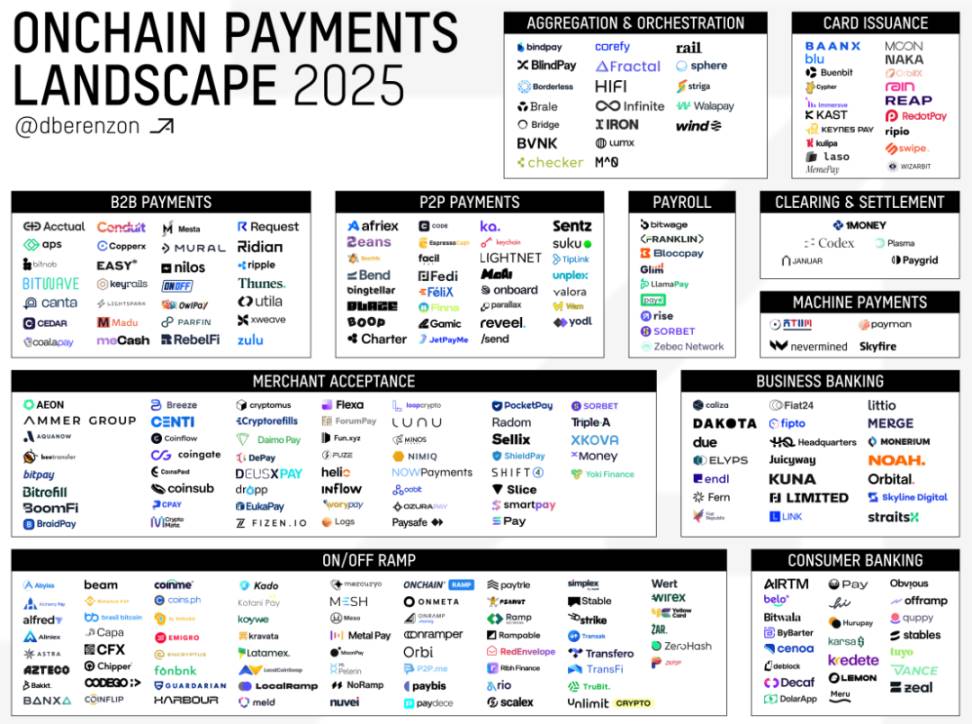
1. Existing Payment Channels
To understand the importance of crypto channels, it is essential to grasp the key concepts of existing payment channels and their complex market structures and system architectures. If you are already familiar with these, feel free to skip this section.
1.1 Card Networks
While the topology of credit card networks is complex, the main participants in credit card transactions have remained unchanged for the past 70 years. Essentially, credit card payments involve four main participants:
Merchant
Cardholder
Issuing Bank
Acquiring Bank
The first two are straightforward, but the latter two deserve explanation.
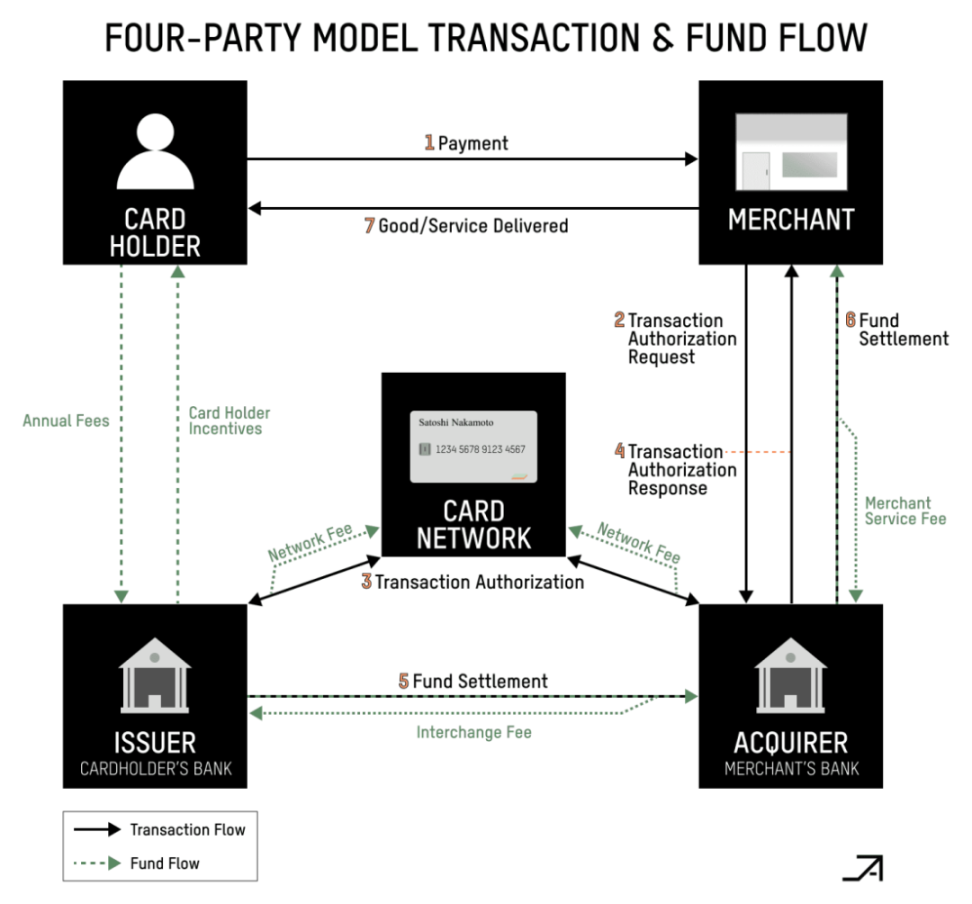
The issuing bank or issuing institution provides credit or debit cards to customers and authorizes transactions. When a transaction request is made, the issuing bank decides whether to approve it by checking the cardholder's account balance, available credit limit, and other factors. A credit card essentially borrows funds from the issuing institution, while a debit card transfers directly from your account.
If a merchant wants to accept credit card payments, they need an acquirer (which can be a bank, payment processor, gateway, or independent sales organization), which is an authorized member of the credit card network. The term acquirer comes from its role in collecting payments on behalf of the merchant and ensuring that these funds reach the merchant's account.
The credit card network itself provides the channels and rules for credit card payments. It connects acquirers with issuing banks, provides clearing functions, establishes participation rules, and determines transaction fees. ISO 8583 remains the primary international standard that defines how credit card payment information (such as authorization, settlement, refunds) is constructed and exchanged among network participants. In the network environment, issuing institutions and acquirers act like their distributors—issuing institutions are responsible for getting more cards into users' hands, while acquirers are responsible for getting as many card terminals and payment gateways into merchants' hands so they can accept credit card payments.
Additionally, there are two types of credit card networks: "open" and "closed." Open networks like Visa and Mastercard involve multiple parties: issuing banks, acquiring banks, and the credit card network itself. The credit card network facilitates communication and transaction routing but acts more like a marketplace, relying on financial institutions to issue credit cards and manage customer accounts. Only banks are allowed to issue credit cards for open networks. Each debit or credit card has a Bank Identification Number (BIN) provided by Visa to the bank, while non-bank entities like PayFacs need a "BIN sponsor" to issue credit cards or process transactions.
In contrast, closed-loop networks like American Express are self-sufficient, with a single company handling all aspects of the transaction process—they typically issue their own cards, act as their own bank, and provide their own merchant acquiring services. The general consideration is that closed-loop systems offer more control and better profits, but at the cost of more limited merchant acceptance. Conversely, open-loop systems provide broader adoption, but at the cost of control and revenue sharing among participants.
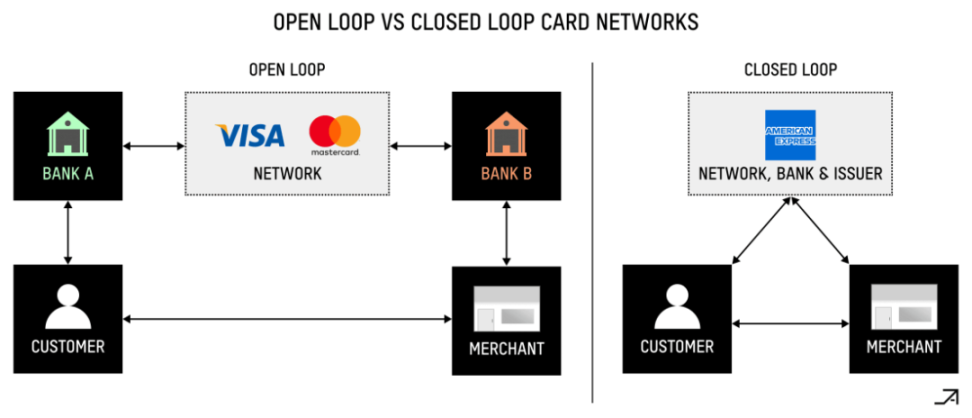
Source: Arvy
The economics of payments are very complex, with multiple layers of fees present in the network. Interchange Fees are a part of the payment fees charged by the issuing bank for providing access to its customers. While technically the acquiring bank pays the interchange fee directly, the cost is often passed on to the merchant. Card networks typically set the interchange fees, which usually account for a significant portion of the total payment cost. These fees vary widely across different regions and transaction types. For example, in the United States, consumer credit card fees range from approximately 1.2% to 3%, while in the European Union, the cap is 0.3%. Additionally, Scheme Fees are also determined by the card networks to compensate for the network's role in connecting acquirers and issuing banks, as well as acting as a "channel" to ensure the accurate flow of transactions and funds. There are also Settlement Fees to be paid to the acquirer, typically a percentage of the transaction settlement amount or transaction volume.
While these are the most important participants in the value chain, the reality is that today's market structure is much more complex in practice:
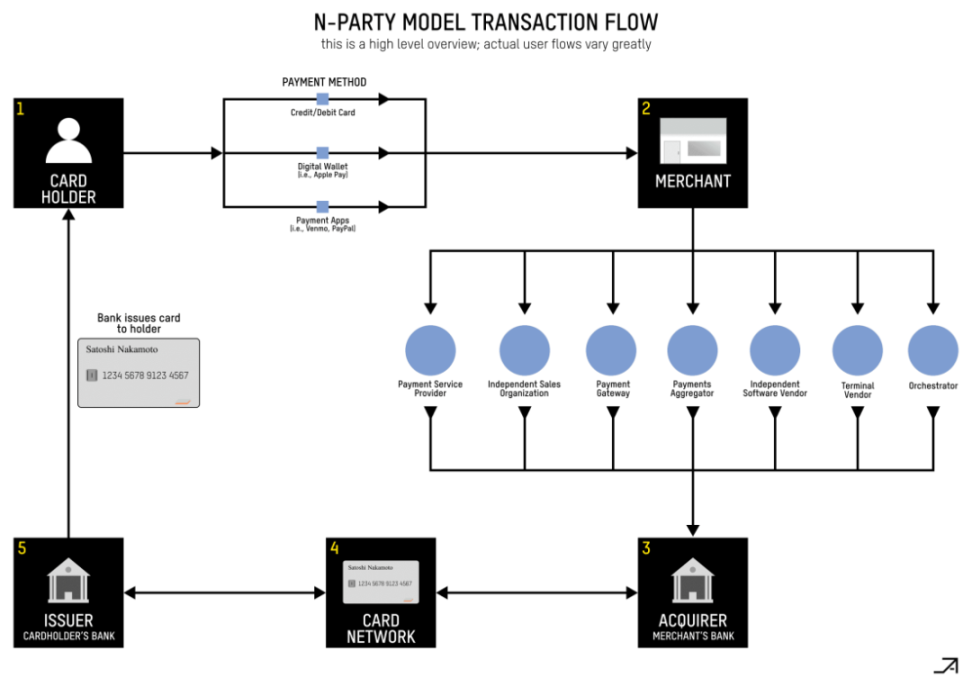
Source: 22nd
In the above link, there are several important participants:
Payment Gateway encrypts and transmits payment information, connecting payment processors and acquirers for authorization, and communicates transaction approvals or rejections to businesses in real-time.
Payment Processor processes payments on behalf of the acquiring bank. It forwards transaction details from the gateway to the acquiring bank, which then communicates with the issuing bank through the card network for authorization. The payment processor receives the authorization response and sends it back to the gateway to complete the transaction. It also handles settlement, which is the process of funds actually entering the merchant's bank account. Typically, businesses send a batch of authorized transactions to the payment processor, which submits these transactions to the acquiring bank to initiate the transfer of funds from the issuing bank to the merchant's account.
Payment Facilitator or Payment Service Provider is a small payment processor that acts as an intermediary between merchants and acquiring banks, first introduced by PayPal and Square around 2010. It effectively acts as an aggregator by bundling many smaller merchants into its system to achieve economies of scale, simplifying operations by managing cash flow, processing transactions, and ensuring payments. PayFacs hold direct merchant IDs from card networks and take on the responsibilities of onboarding, compliance (e.g., anti-money laundering laws), and underwriting for the merchants they partner with.
Orchestration Platform is a middleware technology layer that simplifies and optimizes the payment processes for merchants. It connects to multiple processors, gateways, and acquirers through a single API, improving transaction success rates, reducing costs, and enhancing performance by routing payments based on factors such as location or fees.
1.2 Automated Clearing House
Automated Clearing House (ACH) is one of the largest payment networks in the United States, actually owned by the banks that use it. It was originally established in the 1970s but began to gain popularity when the U.S. government started using it to send Social Security payments, encouraging banks nationwide to join the network. Today, it is widely used for payroll processing, bill payments, and B2B transactions.
ACH transactions primarily fall into two types: credits and debits. When a user receives a paycheck or pays a bill online using a bank account, they are using the ACH network. The process involves multiple participants: the company or individual initiating the payment (the originator), their bank (ODFI), the receiving bank (RDFI), and the operator that facilitates all these transactions. In the ACH process, the originator submits the transaction to the ODFI, which then sends the transaction to the ACH operator, and the ACH operator switches the transaction to the RDFI. At the end of each day, the operator calculates the net settlement totals for its member banks (the Federal Reserve is responsible for managing the actual settlement).

Source: U.S. Payment Systems: A Guide for Payment Professionals
One of the most important things about ACH is how it handles risk. When a company initiates an ACH payment, its bank (ODFI) is responsible for ensuring everything is legitimate. This is especially important for debits—imagine if someone used your bank account information without permission. To prevent this, regulations allow disputes to be raised within 60 days of receiving a statement, and companies like PayPal have developed clever verification methods, such as making small test deposits to confirm account ownership.
The ACH system has been striving to meet modern demands. In 2015, they launched "Same Day ACH," which allows for faster payment processing. Nevertheless, it still relies on batch processing rather than real-time transfers and has limitations. For example, you cannot send more than $25,000 in a single transaction, and it is not suitable for international payments.
1.3 Wire Transfer
Wire transfers are at the core of high-value payment processing, with the two main systems in the U.S. being Fedwire and CHIPS. These systems handle urgent, guaranteed payments that require immediate settlement, such as securities transactions, significant business deals, and real estate purchases. Once executed, wire transfers are typically irreversible and cannot be canceled or revoked without the recipient's consent. Unlike conventional payment networks that process batch transactions, modern wire transfers use Real-Time Gross Settlement (RTGS) systems, meaning each transaction is settled individually as it occurs. This is a crucial feature, as the system processes hundreds of billions of dollars daily, and the risk of bank failures using traditional net settlement is too high.
Fedwire is an RTGS system that allows participating financial institutions to send and receive same-day funds transfers. When a business initiates a wire transfer, its bank verifies the request, debits the account, and sends a message to Fedwire. The Federal Reserve Bank then immediately debits the sending bank's account and credits the receiving bank's account, which subsequently credits the final recipient's account. The system operates on business days from 9 PM the previous night to 7 PM Eastern Time, closing on weekends and federal holidays.
CHIPS, owned by large U.S. banks through a clearinghouse, is a private sector alternative but serves a smaller number of large banks.
Unlike Fedwire's RTGS approach, CHIPS is a Netting Settlement System, meaning it allows multiple payments between the same counterparties. For example, if Alice wants to send Bob $10 million while Bob wants to send Alice $2 million, CHIPS would net these amounts into a single payment of $8 million from Bob to Alice. While this means CHIPS payments take longer than real-time transactions, most payments are still settled within the same day.
As a complement to these systems, SWIFT is not actually a payment system but a global messaging network for financial institutions. It is a cooperative organization owned by its members, whose shareholders represent over 11,000 member organizations. SWIFT enables banks and securities firms worldwide to exchange secure, structured information, much of which initiates payment transactions across various networks. According to Statrys, SWIFT transfers take about 18 hours to complete.
In a typical process, the sender of funds instructs their bank to send a wire transfer to the recipient. The value chain below illustrates a simple case where two banks belong to the same wire transfer network.

Source: U.S. Payment Systems: A Guide for Payment Professionals
In more complex cases, especially for cross-border payments, transactions need to be executed through a Correspondent Banking Relationship, often using SWIFT to coordinate payments.
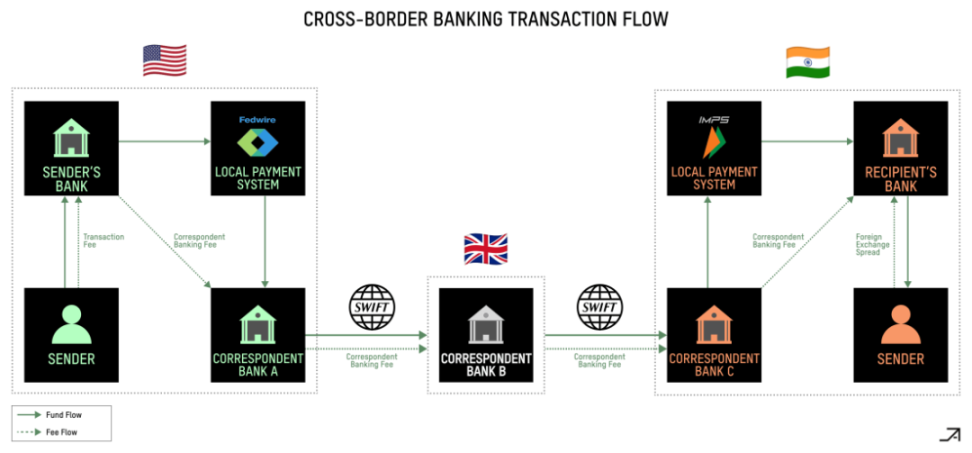
Source: Matt Brown
II. Real-World Use Cases
Now that we have a foundational understanding of traditional payment channels, we can focus on the advantages of crypto payment channels.
Crypto payment channels are most effective in situations where the use of traditional dollars is restricted but demand for dollars is high. Consider those needing dollars to preserve wealth or as a bank alternative but cannot easily access traditional dollar bank accounts; these countries are often economically unstable, have high inflation, currency controls, or underdeveloped banking systems, such as Argentina, Venezuela, Nigeria, Turkey, and Ukraine. Furthermore, it can be argued that the dollar is a superior store of value compared to most other currencies, as consumers and businesses typically prefer dollars because they can easily be used as a medium of exchange or converted into local legal tender at the point of sale.
The advantages of crypto payment channels are also most apparent in the context of globalized payments, as blockchain networks are not bound by national borders; they rely on existing internet connections to provide global coverage. According to the World Bank, there are currently 92 RTGS systems operating worldwide, each typically owned by their respective central banks. While they are ideal for processing domestic payments within those countries, the problem is that they cannot "intercommunicate." Crypto payment channels can act as a glue between these different systems and can extend their reach to countries without these systems.
Cryptocurrency payments are particularly suitable for payments that have a certain degree of urgency or typically higher time preferences. This includes cross-border vendor payments and foreign aid payments. This is especially helpful in scenarios where correspondent banking networks are particularly inefficient. For example, remitting money from Mexico to the United States is actually more difficult than remitting from Hong Kong to the United States, despite the geographical proximity. Even in developed corridors like the U.S. to Europe, payments often need to go through four or more correspondent banks.
On the other hand, crypto payment channels are less attractive for domestic transactions in developed countries, especially where credit card usage is high or real-time payment systems already exist. For instance, internal payments in Europe proceed smoothly through SEPA, and the stability of the euro eliminates the need for dollar-denominated alternatives.
2.1 Merchant Acceptance
Merchant acceptance can be divided into two different use cases: front-end integration and back-end integration. In the front-end approach, merchants can directly accept cryptocurrencies as a payment method from customers. Although this is one of the oldest use cases, historically, it has not seen much transaction volume because few people hold cryptocurrencies, and even fewer want to spend them, with limited useful options for those who do. Today's market is different, as more people hold crypto assets (including stablecoins), and an increasing number of merchants accept them as payment options, allowing them to reach new customer segments and ultimately sell more goods and services.
From a geographical perspective, most transaction volume comes from businesses selling products to consumers in countries/regions that are early adopters of cryptocurrencies, typically emerging markets like China, Vietnam, and India. From the merchant's perspective, most demand comes from online gambling and retail brokerage firms that want to reach users in emerging markets, Web2 and Web3 markets (such as watch suppliers and content creators), and real-money games (like fantasy sports and lotteries).
The "front-end" merchant acceptance process typically looks like this:
The PSP usually creates a wallet for the merchant after KYC/KYB;
Users send cryptocurrencies to the PSP;
The PSP converts the cryptocurrency to fiat currency through liquidity providers or stablecoin issuers and sends the funds to the merchant's local bank account, possibly using other licensed partners.
The main challenge hindering the continued adoption of this use case is psychological, as cryptocurrencies seem "unreal" to many. Two major user roles need to be addressed: one that is completely indifferent to its value and wants to treat everything as magical internet money; the other is pragmatic and directly deposits funds into a bank.
Additionally, in the U.S., consumer adoption of crypto payments is more challenging because credit card rewards effectively pay consumers 1% to 5% cash back on purchases. There have been attempts to persuade merchants to promote crypto payments directly to consumers as an alternative to credit cards, but so far, they have not succeeded. While lowering interchange rates is a good idea for merchants, it is not a concern for consumers. The Merchant Customer Exchange was launched in 2012 and failed in 2016 for this very reason—they could not kickstart the consumer-side adoption flywheel. In other words, getting users to switch from credit card payments to crypto asset payments is difficult for merchants to directly incentivize because payments are already "free" for consumers, so the value proposition should first be addressed at the consumer level.
In the back-end approach, crypto payments can provide merchants with faster settlement times and access to funds. Settlements with Visa and Mastercard can take 2-3 days, American Express takes 5 days, and international settlements can take even longer, such as around 30 days in Brazil. In some use cases, like marketplaces such as Uber, merchants may need to pre-fund their bank accounts to make payments before settlement.
Conversely, people can effectively enter the crypto payment channel through the user's credit card, transfer funds on-chain, and ultimately deposit funds directly into the merchant's bank account in local currency. In addition to improving working capital due to reduced funds tied up in the payment path, merchants can further enhance their cash management by freely and instantly exchanging between digital dollars and yield-bearing assets (like tokenized U.S. Treasuries).
More specifically, the "back-end" merchant acceptance process may look like this:
Users enter their credit card information to complete the transaction;
The PSP creates a wallet for the customer and funds that wallet through an entry point that accepts traditional payment methods;
The credit card transaction purchases USDC and then sends it from the customer's wallet to the merchant's wallet;
The PSP may choose to transfer funds to the merchant's bank account via local rails T+0 (same day);
The PSP typically receives funds from the acquiring bank on T+1 or T+2 (within 1-2 days).
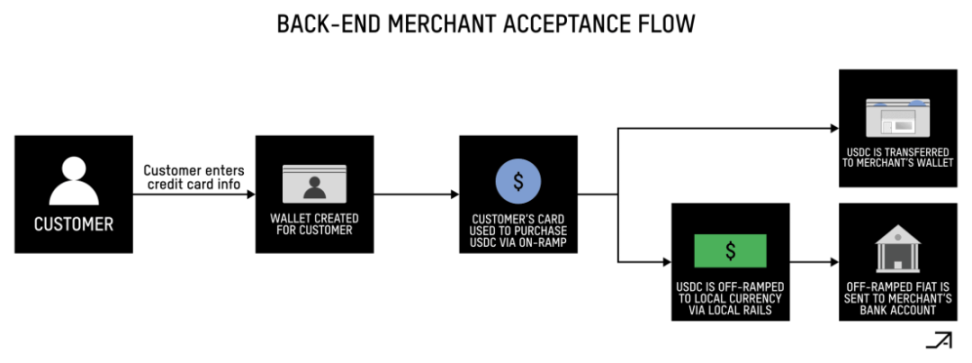
2.2 Debit Cards
The ability to link debit cards directly to non-custodial smart contract wallets creates an unexpectedly powerful bridge between the crypto space and the real world, driving organic adoption among different user roles. In emerging markets, these cards are becoming the primary consumption tool, increasingly replacing traditional banking. Interestingly, even in currency-stable countries, consumers are gradually using these cards to accumulate dollar savings while avoiding foreign exchange (FX) costs at the time of purchase. High-net-worth individuals are also increasingly using these crypto-linked debit cards as an effective tool for spending USDC globally.
The advantages of debit cards over credit cards lie in two factors: debit cards face fewer regulatory restrictions (for example, MCC 6051 is completely rejected in capital-controlled countries like Pakistan and Bangladesh), and debit cards have lower fraud risk, as refunds for settled crypto transactions pose serious liability issues for credit cards.
In the long run, cards tied to crypto wallets for mobile payments may actually be the best way to combat fraud, as mobile phones have biometric verification: scanning your face, spending, and reloading from your bank account to the wallet.
2.3 Remittances
Remittances refer to the act of individuals who move abroad in search of work sending funds back to their home country. According to the World Bank, the total remittance amount in 2023 is approximately $656 billion, equivalent to Belgium's GDP.
The costs of traditional remittance systems are high, resulting in less money in the pockets of recipients. On average, the cost of cross-border remittances is 6.4% of the remittance amount, but these fees vary widely—from 2.2% for remitting from Malaysia to India (even lower for high-volume corridors like the U.S. to India) to as high as 47.6% for remitting from Turkey to Bulgaria. Bank fees are often the highest, around 12%, while average fees for remittance operators like MoneyGram are about 5.5%.
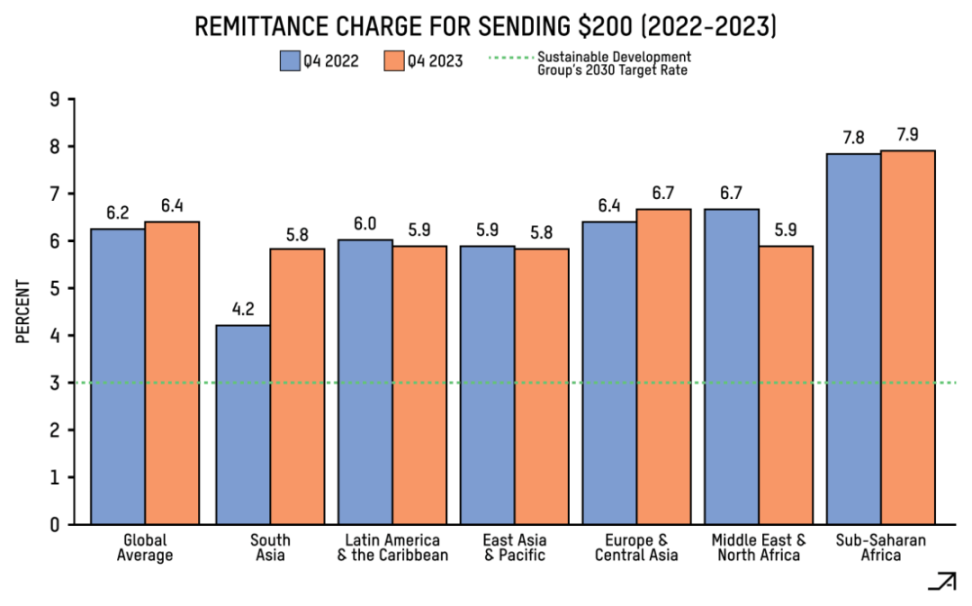
Source: World Bank
Crypto payments can provide a faster and cheaper way to send remittances overseas, and the number of such companies largely depends on the broader remittance market size, with the largest transaction volume channels being from the U.S. to Latin America (especially Mexico, Argentina, and Brazil), the U.S. to India, and the U.S. to the Philippines. A significant factor driving this trend is non-custodial embedded wallets, which provide users with a Web2-level user experience.
The process for making remittance payments using crypto payments may look like this:
The sender accesses the PSP via a bank account, debit card, credit card, or directly to an on-chain address; if the sender does not have a wallet, one will be created for them;
The PSP converts USDT/USDC to the recipient's local currency, which can be done directly or through market makers or OTC partners;
The PSP pays the fiat currency to the recipient's bank account, which can be paid directly from their integrated bank account or through a local payment gateway; alternatively, the PSP can first generate a non-custodial wallet for the recipient to receive funds and let them choose to keep it on-chain;
In many cases, the recipient needs to complete KYC before receiving the funds.
Despite this, the market promotion path for crypto remittance projects remains challenging. One issue is that you often need to incentivize people to leave remittance operators, which can be costly. Another issue is that most transfer applications on Web2 already offer free transfers, so local transfers alone are insufficient to overcome the network effects of existing applications. Finally, while the on-chain transfer components work well, you still need to interact with traditional banking institutions for the "last mile," so due to the costs and friction of currency conversion for deposits and withdrawals, users may ultimately encounter the same or even worse issues. In particular, payment gateways that convert to local fiat currency and allow payment in customized ways, such as via mobile phones or self-service terminals, will capture the largest profit margins.
2.4 B2B Payments
Cross-border (XB) B2B payments are one of the most promising applications of crypto payments due to the inefficiencies of traditional payment systems. Payments through correspondent banking systems can take weeks to settle, and in some extreme cases, even longer—one founder reported that it took them 2.5 months to send vendor payments from Africa to Asia. Another example is that cross-border payments from Ghana to Nigeria (two neighboring countries) can take weeks, with transfer fees reaching up to 10%.
Additionally, cross-border settlements are both slow and expensive for PSPs. For companies like Stripe that facilitate payments, it may take up to a week to pay international merchants, and they must lock up funds to mitigate fraud and refund risks. Shortening conversion cycles will free up significant working capital.
XB B2B payments have made significant progress on crypto channels, primarily because merchants care more about fees than consumers do. Reducing transaction costs by 0.5% to 1% may not sound like much, but when transaction volumes are large, especially for low-margin businesses, this fee becomes quite substantial. Additionally, speed is also important. Completing payments within hours rather than days or weeks has a significant impact on a company's working capital. Furthermore, compared to consumers who expect a smooth out-of-the-box experience, businesses are more tolerant of poorer user experiences and more complex processes.
In addition, the cross-border payment market is vast—estimates from different sources vary widely, but according to McKinsey, the revenue of the cross-border payment market was approximately $240 billion in 2022, with a transaction volume of about $150 trillion. That said, establishing a sustainable business remains challenging. While the "stablecoin sandwich"—exchanging local currency for stablecoins and then back again—certainly speeds things up, it is also expensive, as currency conversion on both sides erodes profits, often leading to unsustainable unit economics. Although some companies have attempted to address this issue by establishing internal market-making departments, this is very asset-liability intensive and difficult to scale. Additionally, the customer base is relatively slow, concerned about regulation and risk, and often requires significant education.
That said, as stablecoin legislation opens the door for more businesses to hold and operate digital dollars, foreign exchange costs may decline rapidly over the next two years. With more currency conversion and token issuers having direct banking relationships, they will be able to effectively offer wholesale conversion rates at internet scale.
2.4.1 XB Supplier Payments
For B2B payments, most cross-border transactions involve importers paying suppliers, typically with buyers in the U.S., Latin America, or Europe, and suppliers in Africa or Asia. The local payment channels in these countries are underdeveloped, making it difficult to find local banking partners. Crypto payments can also help alleviate pain points in specific countries/regions. For example, in Brazil, you cannot use traditional payment channels to pay millions of dollars, making international payments difficult for businesses. Some well-known companies, such as SpaceX, are already using crypto payments to achieve this use case.
2.4.2 XB Receivables
Businesses with global customers often find it challenging to collect funds in a timely and efficient manner. They typically work with multiple PSPs to collect funds locally, but they need a fast way to receive payments, which can take days or even weeks, depending on the country/region. Crypto payments are faster than SWIFT transfers, compressing the time to T+0.
Here is an example of the payment process for a Brazilian company purchasing goods from a German company:
The buyer sends Reais to the PSP via PIX;
The PSP converts Reais to USD and then to USDC;
The PSP sends USDC to the seller's wallet;
If the seller wants local fiat currency, the PSP sends USDC to a market maker or OTC to convert it to local currency;
If the seller has a license/bank account, the PSP can remit to the seller via local payment channels; if not, they can use local partners.
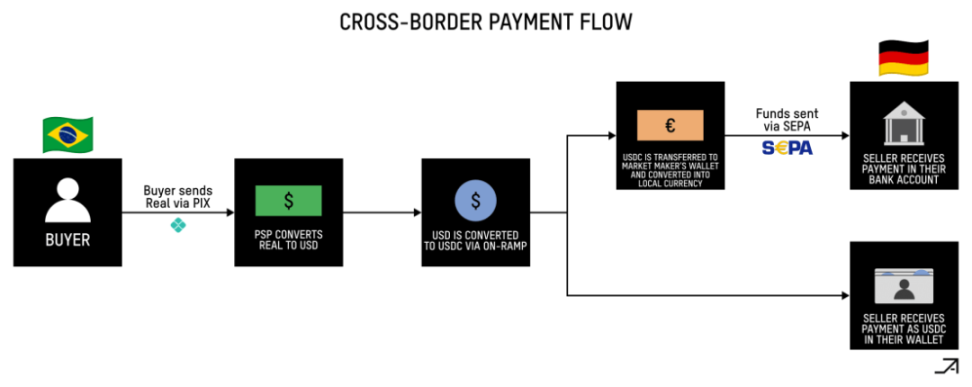
2.4.3 Treasury Operations
Companies can also use crypto payment channels to improve treasury operations and accelerate global expansion. They can hold dollar balances and use local currency conversion channels to reduce foreign exchange risk and enter new markets more quickly, even if local banks are unwilling to support them. They can also use crypto payment channels as an internal means to restructure and repatriate funds between the countries where they operate.
2.4.4 Foreign Aid Disbursement
Another common use case for B2B is time-sensitive payments, where these crypto channels can be used to reach recipients more quickly. One example is foreign aid payments—allowing NGOs to use crypto payment channels to send money to local export agents, who can then pay eligible individuals separately. This is particularly effective in economies where the local financial system and/or government is very weak. For instance, in countries like South Sudan, where the central bank has collapsed, local payments can take over a month. But as long as there is a mobile phone and internet connection, there are ways to bring digital currency into the country, allowing individuals to exchange digital currency for fiat and vice versa.
The payment process for this use case may look like this:
The NGO provides funds to the PSP;
The PSP sends a bank transfer to the OTC partner;
The OTC partner converts fiat currency to USDC and sends it to the local partner's wallet;
The local partner acquires USDC through peer-to-peer (P2P) traders.
2.5 Payroll
From the consumer's perspective, one of the most promising early adopters is freelancers and contractors, especially in emerging markets. The value proposition for these users is that more money will ultimately end up in their pockets rather than flowing to intermediaries, and this money can be in digital dollars. This use case also brings cost benefits to the businesses on the other side sending large payments, particularly useful for crypto-native companies (like exchanges) that already hold most of their funds in cryptocurrency.
The process for contractor payments typically looks like this:
The company undergoes KYB/KYC with the PSP;
The company sends dollars to the PSP or sends USDC to the wallet address linked to the contractor;
The contractor can decide whether to keep it as cryptocurrency or withdraw it to a bank account, and the PSP typically has some master service agreements with one or more OTC partners holding relevant licenses in their respective jurisdictions for local payments.
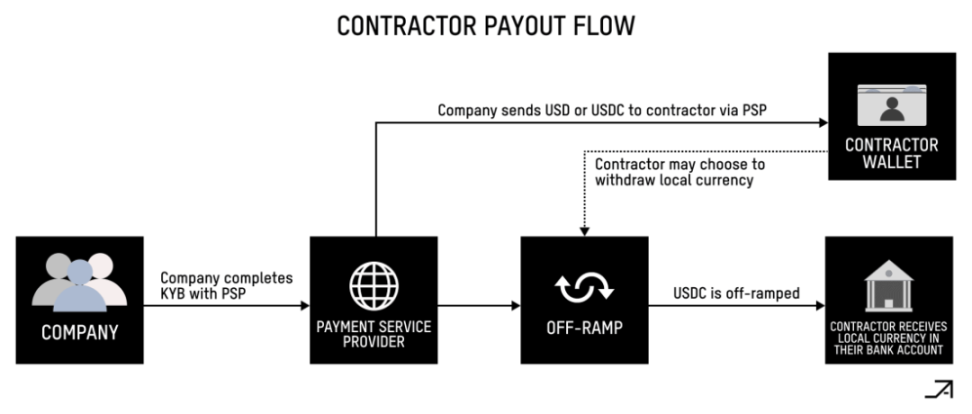
2.6 On/Off-ramps
On/Off-ramps are a competitive and crowded market. While many early attempts failed to scale, the market has matured over the past few years, with many companies operating sustainably and providing local payment channels globally. While on/off-ramps can be used as standalone products (such as simply buying crypto assets), they can be considered the most critical part of the bundled services (like payments) payment process.
Building on/off-ramps typically involves three components: obtaining the necessary licenses (e.g., VASP, MTL, MSB), ensuring local banking partners or PSPs can access local payment channels, and connecting with market makers or OTC desks for liquidity.
Initially, exchanges were the dominant players in the entry channels, but today, an increasing number of liquidity providers (from small forex and OTC desks to larger trading firms like Cumberland and FalconX) are providing entry channels. These companies can typically handle transaction volumes of up to $100 million daily, making it unlikely for them to run out of liquidity for popular assets. Some teams may even prefer them because they can commit to spreads, which helps control profit margins.
Due to licensing, liquidity, and orchestration complexities, the non-U.S. portion of on/off-ramps is generally much more challenging than the U.S. portion. This is especially true in Latin America and Africa, where there are dozens of currencies and payment methods. For example, you can use PDAX in the Philippines, as it is the largest cryptocurrency exchange there, but in Kenya, you need to use several local partners like Clixpesa, Fronbank, and Pritium depending on the payment method.
P2P channels rely on a network of "agents"—local individuals, currency providers, and small businesses like supermarkets and pharmacies—that provide liquidity for fiat and stablecoins. These agents are particularly prevalent in Africa, where many people already operate mobile money stalls for services like MPesa, and their primary motivation is economic incentives—they earn money through transaction fees and foreign exchange spreads. In fact, for individuals in high-inflation economies like Venezuela and Nigeria, becoming an agent is often more profitable than traditional service jobs like taxi driving or food delivery. They can also work from home using their phones, usually requiring just a bank account and mobile money to get started. The strength of this system lies in its ability to support dozens of local payment methods without formal licensing or integration, as transfers occur between individual bank accounts.
Notably, the foreign exchange rates in P2P channels are often more competitive. For example, banks in Khartoum, Sudan, typically charge up to 25% in foreign exchange fees, while local cryptocurrency P2P ramps offer foreign exchange fees of 8% to 9%, which are effectively market rates rather than the forced rates imposed by banks. Similarly, P2P channels can provide foreign exchange rates that are about 7% cheaper than those of banks in Ghana and Venezuela. Generally, in countries with a larger supply of dollars, the spreads are smaller. Additionally, the best markets for P2P channels are those with high inflation, high smartphone penetration, weak property rights, and unclear regulatory standards, as financial institutions do not engage with cryptocurrencies, creating an environment conducive to the flourishing of self-custody and P2P.
The payment process for P2P entry may look like this:
Users can choose or automatically designate a counterparty or "agent" that already holds USDT, which is typically hosted by the P2P platform;
Users send fiat currency to the agent via local payment channels;
The agent confirms receipt and sends USDT to the user.
From a market structure perspective, most on/off-ramps are commoditized, with low customer loyalty, as they typically choose the cheapest option. To remain competitive, local payment channels may need to expand their coverage, optimize for the most popular channels, and find the best local partners. In the long run, we may see each country/region consolidate into several on/off-ramp channels, each with comprehensive licensing, supporting all local payment methods, and providing maximum liquidity. In the medium term, aggregators will be particularly useful, as local providers are often faster and cheaper, while bundled options typically offer consumers the best prices and completion rates. If they can effectively optimize and route payments across hundreds of partners and routes, they may also suffer the least from commoditization. This also applies to orchestration platforms, including compliance, PSP selection, banking partner selection, and card issuance as value-added services.
From the consumer's perspective, the good news is that fees may trend toward zero. We are already seeing this today on Coinbase, where the cost of instant conversion from USD to USDC is $0. In the long run, most stablecoin issuers may provide this service for large wallets and fintech companies, further compressing fees.
### Compliance and Regulatory Licensing
Obtaining regulatory licenses is a painful but necessary step to expand the application of crypto payments. For startups, there are two approaches: partnering with already licensed entities or obtaining licenses independently. Collaborating with licensed partners allows startups to bypass the high costs and lengthy timelines associated with obtaining licenses themselves, but the trade-off is reduced profit margins, as a significant portion of revenue goes to the licensed partner. Alternatively, startups can choose to invest upfront (potentially hundreds of thousands to millions of dollars) to obtain licenses independently. While this route often takes months or even years (one project reported spending 2 years), it enables startups to offer a more comprehensive product directly to users.
Although there are established schemes for obtaining regulatory licenses in many jurisdictions, achieving global licensing coverage is extremely challenging, if not impossible, as each region has its own unique currency transfer regulations, requiring over 100 licenses to cover the globe. For example, in the U.S. alone, a project needs a money transfer license (MTL) for each state, a BitLicense for New York, and registration as a money services business (MSB) with the Financial Crimes Enforcement Network. Simply obtaining all state MTLs can cost between $500,000 and $2 million and may take up to a year. Overseas, the requirements are equally dizzying. Importantly, non-custodial startups that do not touch funds can often bypass immediate licensing requirements and enter the market more quickly.
### Challenges
The widespread adoption of payment methods is often difficult because it presents a chicken-and-egg problem. Either consumers need to widely adopt a payment method, which will force merchants to accept it, or merchants need to use a specific payment method, which will compel consumers to adopt it. For example, before Uber became popular in 2012, credit cards were a niche market in Latin America; everyone wanted a credit card because it allowed them to use Uber, which was safer and (initially) cheaper than taxis. This led to the popularity of other on-demand applications like Rappi, as people now had smartphones and credit cards. This created a virtuous cycle where more people wanted credit cards because there were more cool applications requiring credit card payments.
The same applies to mainstream consumer adoption of crypto payments. We have yet to see use cases where paying with stablecoins is particularly advantageous or absolutely necessary, although debit cards and remittance applications are bringing us closer to that moment. If P2P applications can unlock a new online behavior, they have a chance—micro-payments and creator payments seem to be exciting candidates. This generally applies to consumer applications, which will not be adopted without incremental functional improvements to the status quo.
There are still some issues regarding on/off-ramps:
High failure rates: If you have tried to enter using a credit card, you understand the frustration.
User experience barriers: While early adopters may tolerate the pain of acquiring assets through exchanges, most early users may prefer to use specific applications directly. To support this, we need smooth in-app upgrades, preferably through Apple Pay.
High costs: Access fees remain very expensive—depending on the provider and region, fees can still be as high as 5% to 10%.
Inconsistent quality: There are still significant disparities in reliability and compliance, especially with non-dollar currencies.
One under-discussed issue is privacy. While privacy is not currently a serious concern for individuals or companies, it will become an issue once crypto payments are adopted as a primary mechanism for business. When malicious actors begin to monitor the payment activities of individuals, companies, and governments through public keys, serious negative consequences will arise. One way to address this issue in the short term is to "protect privacy through obfuscation," initiating a new wallet each time funds need to be sent or received on-chain.
Additionally, establishing banking relationships is often the most challenging part, as it presents another chicken-and-egg problem. If banking partners see transaction volume and profit, they will accept you, but you need banks first to achieve that transaction volume. Moreover, currently, only 4-6 small banks in the U.S. support crypto payment companies, and some of these banks have already reached internal compliance limits. Part of the reason is that crypto payments are still classified as "high-risk activities," similar to cannabis, adult media, and online gambling.
The root of this issue is that compliance has not yet reached the level of traditional payment companies. This includes compliance with AML/KYC and travel rule regulations, OFAC screening, cybersecurity policies, and consumer protection policies. More challenging is directly integrating compliance into crypto payments rather than relying on out-of-band solutions and companies. Lightspark's universal currency address provides a creative solution to this challenge by facilitating compliance data exchange among participating institutions.
### Future Outlook
From the consumer perspective, we are currently at a stage where certain demographics are beginning to accept stablecoins, particularly freelancers, contractors, and remote workers. By leveraging credit card networks to provide consumers with dollar exposure and everyday spending capabilities, we are also getting closer to the demand for dollars in emerging economies. In other words, debit cards and embedded wallets have become the "bridges" that bring cryptocurrency to mainstream consumers in an intuitive form off-chain. In the business realm, we are at the nascent stage of mainstream adoption. Companies are using stablecoins at scale, and this number will significantly increase over the next decade.
Considering all of this, here are my 20 predictions for the state of the industry over the next 5 years:
The payment volume through crypto channels will be between $200 billion and $500 billion annually, primarily driven by B2B payments.
More than 30 new banks globally will launch natively on crypto payment channels.
Fintech companies will compete to remain relevant, with dozens of crypto-native companies being acquired.
Some cryptocurrency companies (possibly stablecoin issuers) will acquire fintech companies and banks that are struggling due to high CAC and operational costs.
Approximately 3 crypto networks (L1 and L2) will emerge, scaling with architectures designed specifically for payments. Such networks will be conceptually similar to Ripple but will have reasonable tech stacks, economic models, and go-to-market strategies.
80% of online merchants will accept cryptocurrency as a payment method, either by expanding their product offerings through existing PSPs or by providing a better experience through crypto-native payment processors.
Card networks will expand to cover about 240 countries and regions (currently around 210), using stablecoins as a last-mile solution.
The majority of remittance volume through 15 global remittance corridors will occur via crypto payment channels.
On-chain privacy primitives will eventually be adopted, driven by enterprises and nations using crypto payment channels rather than consumers.
10% of all foreign aid disbursements will be sent through crypto payment channels.
The market structure for on/off-ramps will become rigid, with 2-3 suppliers in each country capturing the majority of transaction volume and partnerships.
The number of liquidity providers for P2P currency on-ramps will be as numerous as food delivery workers in their respective countries. As transaction volumes increase, agents will become economically sustainable jobs and continue to offer foreign exchange rates at least 5% to 10% cheaper than bank quotes.
Over 10 million remote workers, freelancers, and contractors will receive service payments through crypto payment channels (paid directly in stablecoins or local currency).
99% of AI agent commerce (including agent-to-agent, agent-to-person, and person-to-agent) will occur on-chain via crypto payment channels.
Over 25 well-known partner banks in the U.S. will support companies operating on crypto payment channels, alleviating bottlenecks exacerbated by operational constraints.
Financial institutions will attempt to issue their own stablecoins to facilitate global real-time settlement.
Standalone "crypto Venmo" applications will still struggle to gain popularity, as user roles remain too niche, but large messaging platforms like Telegram will integrate crypto payment channels and begin to be used for P2P payments and remittances.
Due to reduced capital tied up in transit, lending and credit companies will begin to collect and disburse payments through crypto payment channels to improve their working capital.
Several non-dollar stablecoins will begin large-scale tokenization, giving rise to on-chain foreign exchange markets.
Due to government bureaucracy, CBDCs will remain in experimental phases and have not yet reached commercial scale.
### Conclusion
As Stripe CEO Patrick Collison stated, crypto channels are the superconductors of payments. They form the foundation of a parallel financial system that offers faster settlement times, lower fees, and the ability to operate seamlessly across borders. This idea took a decade to mature, but today we see hundreds of companies working to make it a reality. Over the next decade, we will see crypto channels become central to financial innovation, driving global economic growth.
免责声明:本文章仅代表作者个人观点,不代表本平台的立场和观点。本文章仅供信息分享,不构成对任何人的任何投资建议。用户与作者之间的任何争议,与本平台无关。如网页中刊载的文章或图片涉及侵权,请提供相关的权利证明和身份证明发送邮件到support@aicoin.com,本平台相关工作人员将会进行核查。



